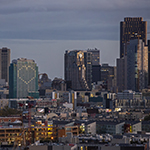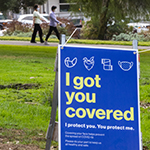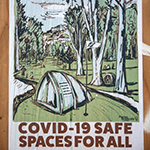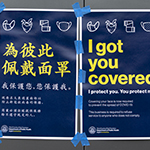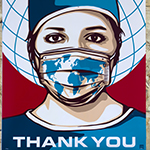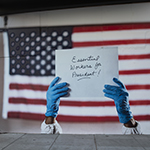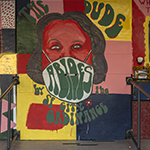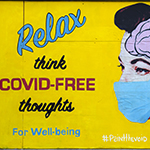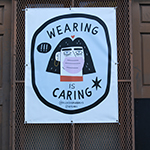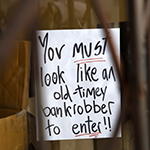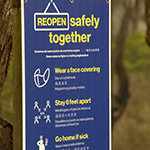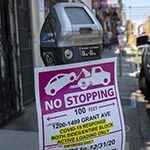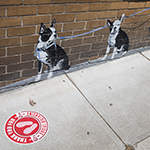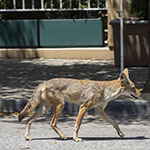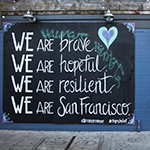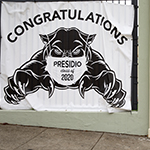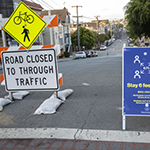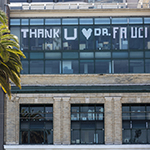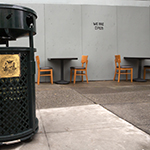|
INTRODUCTION TO GALLERY
Press Esc to close
INTRODUCTION TO COVID-19 GALLERY The COVID-19 experience in San Francisco started in March with businesses beginning to slowly to shut down as street art and murals started popping up honoring healthcare workers who were putting their own lives in danger to help others. The virus, how it was transmitted and who were the most susceptible, how it affected its victims, was not fully understood. People started to recognize “essential workers,” people like the police, firefighters, garbage collectors, construction workers, and especially delivery and restaurant workers who gave us some sense of normalcy. High school graduations were skipped due to rules of social distancing, so people improvised. One private school hired a billboard for an advertisement honoring it’s graduating class. Parents decorated their cars or put up signs in their front yards honoring their child’s accomplishments. Because children were sequestered at home, their drawings began to appear on windows facing the street. I saw one church on Geary Street hold services outdoors on the steps and curb. A priest there had been vocal against restrictions on holding indoor services. He was concerned that many of his flock had stopped attending church were putting “safety over sanctity” and “fear has replaced faith.” He said that “COVID is real but please know that news reports on COVID are largely unreal.” Restaurants were closed for indoor service. While the City had built “parklets” (essential seating areas in street-parking spaces in front of businesses) in the past, they were deemed public spaces for anyone to use. By late August/early September there was an explosive growth in restaurant-built parklet construction as restaurants fought to survive. It’s doubtful any building codes were enforced on their construction as they varied in design, many even had restaurant names emblazoned on the “walls”. Some came with outdoor heaters, lights, or wood flooring and walls. Others were more makeshift. The best had some sort of plastic barriers between diners and the streets. Some parklets served other purposes such as a gym parklet in Lower Nob Hill (ironically the instructor didn’t wear a mask as she led her masked group from the sidewalk). These were shutdown after a surge blamed mostly on indoor gatherings for Thanksgiving. How specific businesses applied rules of masks, social distancing, and sanitization on customers varied. Some retail businesses like Trader Joes stores, a bookstore in North Beach and an eyeglass shop in Hayes Valley made customers walk through their businesses in one direction without allowing them to go back. Others permitted customers to walk around freely. Some asked customers to sanitize their hands before entering like the eyeglass shop and instructed you to put the frames you touched in separate containers for cleaning afterwards. When I asked a worker at the bookstore about handling books, he said they had initially thought some restrictions but realized it was impractical. The eyeglass shop, like UCSF, asked customers with cloth masks to put on a surgical mask they provided before entering. At the used clothing store my daughter worked at in the Haight, they had their own strict protocol established by their national headquarters. Most restaurants required customers to have masks when the asked for service, but immediately after a customer sat the rule disappeared. For the first several months, it was rare to see children wearing masks, but as the Fall school season approached it became increasingly common to see children wearing masks. The people who shunned masks the most were, for whatever reason, were the poor, particularly black and Latinxs, and wealthy young while people. December 14 marked the day the electoral college voted to end Donald Trump’s presidency and replace him with Joe Biden. This same day, the deaths due to COVID-19 in the US, arguably largely attributable to Trump’s lack of leadership, passed 300,000 yet vaccinations began. Outdoor dining was banned again after the post-Thanksgiving surge. By January, it was clear that vaccinations were not being distributed and administered at the pace that was expected. Operation Warp Speed was another Trumpian failure. |
||||||||

